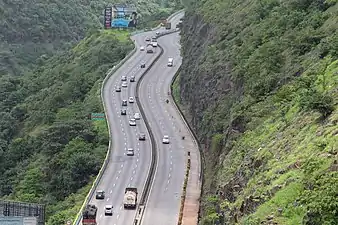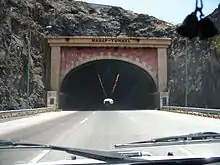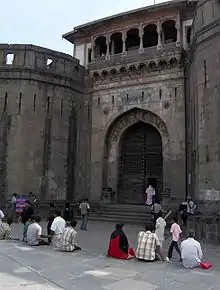Mumbai–Pune Expressway
The Pune Mumbai Expressway (officially Yashwantrao Chavan Expressway) is India's first six-lane concrete, high-speed, access controlled tolled expressway.[1] It spans a distance of 94.5 km connecting Mumbai, the capital of Maharashtra state and the financial capital of India, with Pune, the cultural and educational capital of Maharashtra.[2] The expressway, which was fully operationalized in 2002, introduced new levels of speed and safety in automobile transportation to Indian roads.[3] It is one of India's busiest roads.[4]
| Pune Mumbai Expressway | |
|---|---|
| Yashwantrao Chavan Expressway | |
 Expressway map | |
 | |
| Route information | |
| Maintained by MSRDC | |
| Length | 94.5 km (58.7 mi) |
| Existed | 2002–present |
| Major junctions | |
| West end | Kalamboli, Navi Mumbai |
| East end | Ravet, Pune |
| Location | |
| States | Maharashtra |
| Major cities | Kalamboli, Panvel, Khalapur Khandala, Lonavala, Talegaon Dabhade |
| Highway system | |
The expressway starts at Kalamboli in Mumbai and ends at Kiwale in Pune. It cleaves through the scenic Sahyadri mountain ranges through passes and tunnels.[5] It has five interchanges: Kon (Shedung), Chowk, Khalapur, Kusgaon and Talegaon[6] The expressway has two carriageways, each with three concrete lanes, separated by a central divider and a tarmac or concrete shoulder on either side. Pedestrians, two-wheelers, three-wheelers, bullock carts and tractors are not permitted, although tractor-trailers (semi-trailer rigs) are permitted. Vehicles are also prohibited from halting on the expressway. The expressway handles about 43,000 PCUs daily,[4] and is designed to handle up to 1,00,000 PCUs.[5]
The expressway has reduced the travel time from Kalamboli in Mumbai to Kiwale in Pune to about two hours. It has largely supplemented the Mumbai-Pune section of NH 48 which had become extremely congested and accident-prone.
The expressway is not part of NHAI highway network NH 48 and has been built, operated and maintained wholly by the Government of Maharashtra via Maharashtra State Road Development Corporation. NH 48 is another separate older national highway.
History
The government of Maharashtra appointed RITES and Scott Wilson Kirkpatrick in 1990 to carry out feasibility studies for the new expressway to be operated on toll basis. RITES submitted its report in 1994 with the estimated cost of project at ₹11.46 billion (US$160 million).
The government of Maharashtra entrusted the work of the construction of the expressway to MSRDC in March 1997 on Build-Operate-Transfer basis with permission to collect toll for 30 years. The Ministry of Environment and Forests, Government of India gave environmental clearance on 13 October 1997 and forest clearance on 11 November 1997.
The tender notice was published in leading newspapers all over India and also on the Internet. Due to the wide publicity, 133 tenders were sold and 55 tenders were received on 18 December 1997. After technical and financial evaluation, work orders were given on 1 January 1998 to four contractors. Thereafter tenders for widening of Khandala and Lonavala-Khandala bypass works were invited. The tenders were received on 24 August 1998 and orders were issued on 4 September 1998.[7]
This six-lane project was completed under the stewardship of the Maharashtra State Road Development Corporation (MSRDC). The expressway cost ₹16.3 billion (US$230 million) to construct.[7] The first sections opened in 2000, and the entire route was completed, opened to traffic and made fully operational from April 2002.[5][6] The entire length of expressway has a single layer of barbed wire fencing to keep out stray animals.
Naming
The expressway was conceived and the work started when a coalition of BJP and SS governed Maharashtra.[8] Eventually, in 2009, the then ruling coalition (INC, NCP) named the expressway after the first Chief Minister of Maharashtra, Yashavantrao Chavan, who was a member of the Congress.[9]
Opening
Prior to the opening of the expressway in 2002, the fastest way to travel from Mumbai to Pune was the Deccan Queen train, which completed the journey in just under 3 hours. When the expressway opened, travel time between the cities reduced to 2 hours. The expressway initially opened without a posted speed limit. However, in 2009, a speed limit of 80 km/h (50 mph) was enacted as private vehicles got more powerful and could hit higher speeds more easily. In 2019, a panel of experts agreed to further increase the speed limit to 120 km/h (75 mph).[10]
Tunnels
It has six illuminated, ventilated tunnels totaling 5,724 metres. These tunnels were built by the Konkan Railway Corporation Ltd.

| Tunnel | Description | |
|---|---|---|
| 1 | Bhatan | This tunnel opened in April 2000. The Mumbai-Pune (North) tube is 1,046 m and the Pune-Mumbai (South) tube is 1,086 m long. |
| 2 | Madap | This tunnel also opened in April 2000. The Mumbai-Pune (North) tube is 295 m and the Pune-Mumbai (South) tube is 351 m long. |
| 3 | Adoshi | This tunnel contains only a half part of the expressway which goes from Pune to Mumbai. The Mumbai-Pune carriageway skirts the eastern edge of the tunnel while the Pune-Mumbai carriageway traverses the 230-metre-long (750 ft) tunnel. |
| 4 | Khandala | This is a curved pair of tubes. The Mumbai-Pune (North) tube is 320 m and the Pune-Mumbai (South) tube is 360 m long. |
| 5 | Kamshet-1 | The Mumbai-Pune (North) tube is 935 m and the Pune-Mumbai (South) tube is 972 m long. |
| 6 | Kamshet-2 | The Mumbai-Pune (North) tube is 191 m and the Pune-Mumbai (South) tube is 168 m long. |
distance
| Description | Distance | |
|---|---|---|
| 1 | Start of Expressway (Mumbai end) (19°01′11.47″N 73°06′13.21″E) to Kon-Shedung interchange | 8.5 km (5.3 mi) |
| 2 | Kon-Shedung interchange to Bhatan tunnel | 6.3 km (3.9 mi) |
| 3 | Bhatan tunnel to Madap tunnel | 10.6 km (6.6 mi) |
| 4 | Madap tunnel to Khalapur toll station | 7.3 km (4.5 mi) |
| 5 | Khalapur toll station to Khalapur-Sajgaon gas station & rest area | 1.6 km (0.99 mi) |
| 6 | Khalapur-Sajgaon rest area to Adoshi tunnel. The Mumbai-Pune carriageway skirts the eastern edge of the tunnel while the Pune-Mumbai carriageway traverses the 230-metre-long (750 ft) tunnel. |
6.9 km (4.3 mi) |
| 7 | Adoshi tunnel to the Deccan-Konkan stone trestle. |
4.5 km (2.8 mi) |
| 8 | Stone trestle to Khandala tunnel | 0.8 km (0.50 mi) |
| 9 | Khandala tunnel to Khandala | 2.7 km (1.7 mi) |
| 10 | Khandala to Tungarli | 3.5 km (2.2 mi) |
| 11 | Tungarli to Kamshet-1 tunnel | 17.1 km (10.6 mi) |
| 12 | Kamshet-1 tunnel to Kamshet-2 tunnel | 1.2 km (0.75 mi) |
| 13 | Kamshet-2 tunnel to Talegaon toll station | 11.1 km (6.9 mi) |
| 14 | Talegaon toll station to Somatane interchange | 3.4 km (2.1 mi) |
| 15 | Somatane interchange to End of Expressway (Pune end) (18°39′45.85″N 73°43′35.61″E) | 7.6 km (4.7 mi) |
| Total length of Expressway: Start to End | 93.1 km (57.8 mi) |
Toll plazas

Toll is collected at Khalapur (Pali Phata) (for the Mumbai-Pune direction) and at Talegaon (for the Pune-Mumbai direction). The toll ranges from ₹270 (US$3.80) for private cars, to ₹1,750 (US$25) for multi-axle trailer trucks.[11] The toll collection data is kept as secret as per the RTI inquiry raised by activist Vivek Velankar. The expressway contract with the Ideal Road Builders (IRB) has been uploaded but the toll collection details are not there.[12][13] There is no plan to give toll waiver for this expressway.[14]
Accidents and Incidents
The expressway has witnessed a large number of road accidents, attributed to human errors and the large volume of traffic. In the first 10 years since its opening, there were 1,758 accidents with more than 400 fatalities.[15][16]
- On 28 May 2012, 27 people were reported to have died and another 26 injured in a road accident when a speeding tempo hit a stationary bus carrying passengers near Khalapur.[17][18]
- On 10 June 2010, at least 10 people were injured and 30 vehicles were damaged in a pileup near Kamshet which occurred when a MSRTC bus skidded inside a tunnel.[19]
The heavy rains in June and July 2015 caused heavy landslides at Khandala and Adoshi tunnels, which prompted the PWD to remove loose rocks to prevent further landslides.[20] To carry out such works, the expressway near to the Lonavala exit till Khopoli exit was closed from 10 am to 5 pm for 10 days after the landslide near Adoshi tunnel on 18 July 2015 which took three lives and halted the traffic for two months. The boulders fell on both carriageways which caused huge diversion of traffic towards the old highway.[21]
Sporadic instances of robbery have been reported on the highway.[22]
Future expansion
MSRDC has decided to extend the expressway from Kalamboli near Panvel till Sion in Mumbai. The extended stretch will reduce commuting time between Mumbai and Pune by 30 minutes. Under the plan, the Sion Panvel Expressway corridor will be widened, with dedicated lanes for heavy and light vehicles. Service roads will be built for entry and exit at various points. It will also involve constructing a brand new bridge over the Thane creek parallel to the current Vashi Mankhurd Bridge. MSRDC will undertake the expansion project. Work was expected to commence in March 2009 and complete by September 2011. The new 22-km link is expected to cost ₹8 billion (US$110 million). As of July 2016 no work on this extension has been started.
MSRDC is planning to widen the expressway from current 6 lane to 8 lane.[4] The proposal has been presented in Maharashtra Cabinet for approval.
References
- "Mumbai-Pune Expressway, India". Road Traffic Technology. Retrieved 21 August 2010.
- "Rs 7,000-cr project to add more lanes to expressway, NH-4". The Indian express. Express News Agency. 6 February 2015. Retrieved 21 November 2015.
- "Expressway pune mumbai pune, mumbai pune mumbai, express high way nh-4 national highway no4". Punediary.com. Retrieved 21 August 2010.
- "Mumbai-Pune expressway may soon have eight lanes". The Times of India. 23 February 2013.
- "Study of Rockfall at Amritanjan Bridge Site on Mumbai – Pune Expressway – A Case Study" (PDF). Journal of Rock Mechanics and Tunnelling Technology (JRMTT). 13 (2). July 2007. Retrieved 25 July 2019.
- "8 lanes, longest road tunnels soon on Mumbai-Pune Expressway". The Times of India. 6 July 2011. Retrieved 26 July 2019.
- Dandekar, Hemalata C.; Mahajan, Sulakshana (2001). "MSRDC and Mumbai-Pune Expressway: A Sustainable Model for Privatising Construction of Physical Infrastructure?". Economic and Political Weekly. 36 (7): 549–559. ISSN 0012-9976. JSTOR 4410291.
- "Why Maharashtra must thank a watchful Bal Thackeray". Hindustan Times. 17 November 2012. Retrieved 18 July 2019.
- "Now, a controversy over Mumbai-Pune expressway". Rediff. Retrieved 18 July 2019.
- Dedgaonkar, Supriya; Jul 15, Pune Mirror | Updated; 2019; Ist, 07:58. "Now, you can drive down the Mumbai-Pune Expressway at 120 km/h, Gadkari okays panel recommendations". Pune Mirror. Retrieved 18 July 2019.CS1 maint: numeric names: authors list (link)
- Travelling to from Pune to Mumbai? Shell out Rs270 on E-way
- Why is Mumbai-Pune Expressway toll collection data a ‘secret’?
- MSRDC - Toll Monitoring Department
- Toll on Mumbai's five entry points to go; no waiver for Mumbai-Pune expressway
- "Asiad bus looted on expressway". The Times of India. 23 February 2004. Retrieved 21 July 2010.
- Umbrajkar, Manish (13 May 2009). "MSRDC should handle security on e-way: Bokey". The Times of India. Retrieved 21 July 2010.
- "26 killed in road accident on Mumbai-Pune expressway". The Times of India. Retrieved 28 May 2012.
- "27 killed in accident on Mumbai-Pune expressway". Hindustan Times. Mumbai. 28 May 2012. Archived from the original on 31 May 2012. Retrieved 28 May 2012.
- "10 injured, 30 vehicles damaged in major pile-up on expressway". Pune: Dainik Bhaskar. 10 June 2012. Retrieved 15 June 2012.
- "Another landslide near Khandala disrupts Mumbai-Pune Expressway traffic - Times of India". The Times of India. Retrieved 21 June 2017.
- "Landslide on Pune-Mumbai Expressway kills 3, halts traffic - Times of India". The Times of India. Retrieved 21 June 2017.
- "Expressway turns into a fast lane for robbers". The Times of India. 25 February 2002. Retrieved 21 July 2010.
External links
| Wikimedia Commons has media related to Mumbai Pune expressway. |



